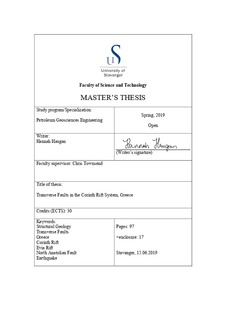| dc.contributor.advisor | Townsend, Chris | |
| dc.contributor.author | Haugan, Hannah | |
| dc.coverage.spatial | Aegean Sea, Greece | nb_NO |
| dc.date.accessioned | 2019-09-30T12:09:23Z | |
| dc.date.available | 2019-09-30T12:09:23Z | |
| dc.date.issued | 2019-06 | |
| dc.identifier.uri | http://hdl.handle.net/11250/2619393 | |
| dc.description | Master's thesis in Petroleum Geosciences Engineering | nb_NO |
| dc.description.abstract | The area around the Aegean Sea contains one of the most seismically active continental regions in the world. The region is composed of two WNW-ESE trending rift systems: Corinth Rift and the Evia Rift as well as a major strike-slip tectonic fault, the North Anatolian Fault (NAF). All the different structural areas have been investigated in several studies, with the E-W faults as the main focus in the rift systems, and the northern parts of the strike-slip fault for the NAF. Few have looked at the N-S trending faults in the two rift systems together in relation to a potential connection to the North Anatolian Fault, which is what this study had as a main focus.
Observations from both of the rift systems show indications of transverse N-S striking structures, and observations from the river valleys in the southern part of the Corinth Rift system seem to support an underlying fault control for the N-S structures. Field observations, earthquake and previous studies as basis are used to conduct a structural analysis. Through the structural analysis, lineaments were connected and traced through both rift systems, giving indications of one continuous system, with two grabens (GoC and GoE) and a horst structure in the middle (Parnassos Mountain). The lineaments could be continued into the Aegean Sea and a hypothesis of the NAF having “horsetail” extending down towards the two rift systems have been raised.
The area is located north of the Hellenic Subduction zone, and the tectonic complexity of the Aegean Sea has previously been explained using the subduction model. The earthquakes in the area do not support the subduction model, and another explanation is sought to better explain the area. | nb_NO |
| dc.language.iso | eng | nb_NO |
| dc.publisher | University of Stavanger, Norway | nb_NO |
| dc.relation.ispartofseries | Masteroppgave/UIS-TN-IER/2019; | |
| dc.rights | Attribution-NonCommercial-NoDerivatives 4.0 Internasjonal | * |
| dc.rights | Attribution-NoDerivatives 4.0 Internasjonal | * |
| dc.rights | Navngivelse 4.0 Internasjonal | * |
| dc.rights.uri | http://creativecommons.org/licenses/by/4.0/deed.no | * |
| dc.subject | Greece | nb_NO |
| dc.subject | Evia Rift | nb_NO |
| dc.subject | North Anatolian Fault | nb_NO |
| dc.subject | Corinth Rift | nb_NO |
| dc.subject | petroleumsgeologi | nb_NO |
| dc.subject | stuctural geology | nb_NO |
| dc.subject | tansverse faults | nb_NO |
| dc.subject | petroleum geology | nb_NO |
| dc.title | Transverse Faults in the Corinth Rift System, Greece | nb_NO |
| dc.type | Master thesis | nb_NO |
| dc.subject.nsi | VDP::Technology: 500::Rock and petroleum disciplines: 510::Geological engineering: 513 | nb_NO |
| dc.subject.nsi | VDP::Mathematics and natural science: 400::Geosciences: 450::Petroleum geology and petroleum geophysics: 464 | nb_NO |

